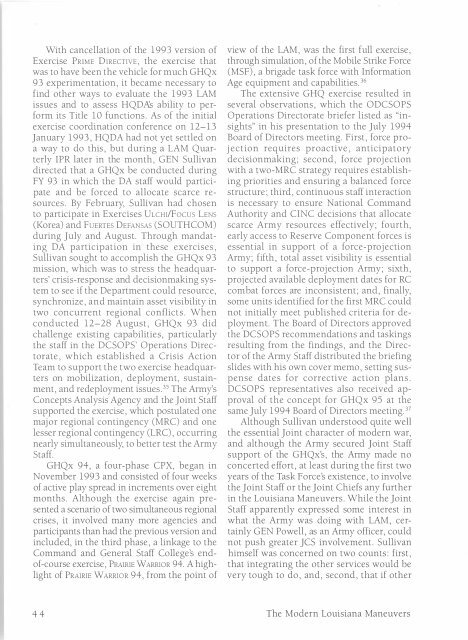The Modern Louisiana Maneuvers - US Army Center Of Military History
The Modern Louisiana Maneuvers - US Army Center Of Military History
The Modern Louisiana Maneuvers - US Army Center Of Military History
Create successful ePaper yourself
Turn your PDF publications into a flip-book with our unique Google optimized e-Paper software.
With cancellation of the 1993 version of<br />
Exercise PRIME DIRECTIVE, the exercise that<br />
was to have been the vehicle for much GHQx<br />
93 experimentation, it became necessary to<br />
find other ways to evaluate the 1993 LAM<br />
issues and to assess HQDA's ability to perform<br />
its Title 10 functions. As of the initial<br />
exercise coordination conference on 12-13<br />
January 1993, HQDA had not yet settled on<br />
a way to do this, but during a LAM Quarterly<br />
IPR later in the month, GEN Sullivan<br />
directed that a GHQx be conducted during<br />
FY 93 in which the DA staff would participate<br />
and be forced to allocate scarce resources.<br />
By February, Sullivan had chosen<br />
to participate in Exercises ULCHI/Focus LENS<br />
(Korea) and FUERTES DEFANSAS (SOUTH COM)<br />
during July and August. Through mandating<br />
DA participation in these exercises,<br />
Sullivan sought to accomplish the GHQx 93<br />
mission, which was to stress the headquarters'<br />
crisis-response and decisionmaking system<br />
to see if the Department could resource,<br />
synchronize, and maintain asset visibility in<br />
two concurrent regional conflicts. When<br />
conducted 12-28 August, GHQx 93 did<br />
challenge existing capabilities, particularly<br />
the staff in the DCSOPS' Operations Directorate,<br />
which established a Crisis Action<br />
Team to support the two exercise headquarters<br />
on mobilization, deployment, sustainment,<br />
and redeployment issues 35 <strong>The</strong> <strong>Army</strong>'s<br />
Concepts Analysis Agency and the Joint Staff<br />
supported the exercise, which postulated one<br />
major regional contingency (MRC) and one<br />
lesser regional contingency (LRC) , occurring<br />
nearly simultaneously, to better test the <strong>Army</strong><br />
Staff.<br />
GHQx 94, a four-phase CPX, began in<br />
November 1993 and consisted of four weeks<br />
of active play spread in increments over eight<br />
months. Although the exercise again presented<br />
a scenario of two simultaneous regional<br />
crises, it involved many more agencies and<br />
participants than had the previous version and<br />
included, in the third phase, a linkage to the<br />
Command and General Staff College's endof-course<br />
exercise, PRAIRIE WARRIOR 94. A highlight<br />
of PRAIRIE WARRIOR 94, from the point of<br />
44<br />
view of the LAM, was the first full exercise,<br />
through simulation, of the Mobile Strike Force<br />
(MSF), a brigade task force with Information<br />
Age equipment and capabilities 36<br />
<strong>The</strong> extensive GHQ exercise resulted in<br />
several observations, which the ODCSOPS<br />
Operations Directorate briefer listed as "insights"<br />
in his presentation to the July 1994<br />
Board of Directors meeting. First, force projection<br />
requires proactive, anticipatory<br />
decisionmaking; second, force proj ection<br />
with a two-MRC strategy requires establishing<br />
priorities and ensuring a balanced force<br />
structure; third, continuous staff interaction<br />
is necessary to ensure National Command<br />
Authority and CINC decisions that allocate<br />
scarce <strong>Army</strong> resources effectively; fourth,<br />
early access to Reserve Component forces is<br />
essential in support of a force-proj ection<br />
<strong>Army</strong>; fifth, total asset visibility is essential<br />
to support a force-projection <strong>Army</strong>; sixth,<br />
projected available deployment dates for RC<br />
combat forces are inconsistent; and, finally,<br />
some units identified for the first MRC could<br />
not initially meet published criteria for deployment.<br />
<strong>The</strong> Board of Directors approved<br />
the DCSOPS recommendations and taskings<br />
resulting from the findings, and the Director<br />
of the <strong>Army</strong> Staff distributed the briefing<br />
slides with his own cover memo, setting suspense<br />
dates for corrective action plans.<br />
DCSOPS representatives also received approval<br />
of the concept for GHQx 95 at the<br />
same July 1994 Board of Directors meeting 3?<br />
Although Sullivan understood quite well<br />
the essential Joint character of modern war,<br />
and although the <strong>Army</strong> secured Joint Staff<br />
support of the GHQx's, the <strong>Army</strong> made no<br />
concerted effort, at least during the first two<br />
years of the Task Force's existence, to involve<br />
the Joint Staff or the Joint Chiefs any further<br />
in the <strong>Louisiana</strong> <strong>Maneuvers</strong>. While the Joint<br />
Staff apparently expressed some interest in<br />
what the <strong>Army</strong> was doing with LAM, certainly<br />
GEN Powell, as an <strong>Army</strong> officer, could<br />
not push greater JCS involvement. Sullivan<br />
himself was concerned on two counts: first,<br />
that integrating the other services would be<br />
very tough to do, and, second, that if other<br />
<strong>The</strong> <strong>Modern</strong> <strong>Louisiana</strong> <strong>Maneuvers</strong>
















